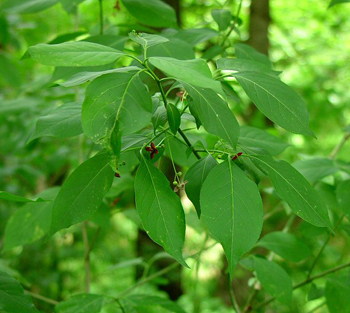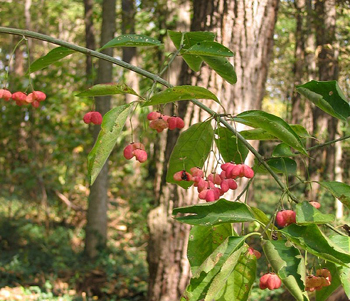Contents:
Common Names | Parts Usually Used | Plant(s) & Culture | Where Found | Medicinal Properties | Biochemical Information
Legends, Myths and Stories | Uses | Formulas or Dosages | Nutrient Content | How Sold | Warning | Bibliography
Scientific Names

- Euonymus atropurpureus L.
- E. europoeus
- Celastracaea
- Staff-tree family
Common Names
- Arrow-wood
- Bitter ash
- Burning bush
- Euonymus
- Indian arrow
- Indian arrowroot
- Indian arrow wood
- Indian root
- Pegwood
- Spindle tree
- Strawberry tree
- Wauhoo
- Whahow
Parts Usually Used
Bark and root bark
Back to Top
Description of Plant(s) and Culture

Wahoo is a deciduous shrub or small tree that grows up to 25 feet high. The bark is gray and its smooth, somewhat quadrangular branches bear opposite, elliptic, pointed leaves that are finely serrate and fine-haired underneath. Axillary cymes of 7 or more purple flowers appear during June. The fruit develops in October and is a scarlet, four-lobed capsule containing brown seeds with scarlet arils. Its most striking appearance is presented in winter, when its pale purple fruits have burst open and been exposed by the fallen leaves, all against a backdrop of glaring snow. It is this appearance which has earned it the nickname of burning bush. Wahoo can be recognized by the unusual structure of its fruit after the leaves drop in the autumn.
For medicinal use, the bark should be gathered in the fall. The fruits may be attractive but they are considered poisonous and should not be used.
Back to Top
Where Found
Found in moist woods and along riverbanks in the eastern United States; as far west as Montana and Texas. Ontario to Tennessee, Alabama, Arkansas, Oklahoma to North Dakota.
Back to Top
Medicinal Properties
Cholagogue (increases flow of bile to the intestine), alterative, cardiac, diuretic, expectorant, laxative, tonic
Back to Top
Biochemical Information
Bitter principle, euonic acid, crystalline glucoside, asparagins, fat, culvitol, 14% ash and resins.
Back to Top
Legends, Myths and Stories
The name “Wahoo” is a Native American name, most commonly applied to a large shrub or small tree. The name wahoo is also given to an Elm (Ulmus alata) and another variety, Euonymus americanus.
The European settlers didn’t take long to pick up the Native American applications of wahoo bark, using it for laxative, diuretic, and tonic effects. Something of a nineteenth century fad developed, and the bark went into various patent medicines and was extremely popular for a time in England. It was listed as an official drug plant. In 1912, a report was published showing the plant produced digitalis-like effect on the heart, boosting the herb’s popularity as a heart medicine. But 4 years later wahoo was dropped as an official drug plant, though it continued to be included in the National Formulary until 1947.
Back to Top
Uses
Wahoo was a popular diuretic drug during the nineteenth century. It was also recommended for chest and lung congestion, indigestion, excellent laxative, used to treat malaria (better than quinine they say), dropsy, and fever. After the discovery early this century that wahoo has a digitalis-like effect on the heart, it also became popular as a cardiac drug.
It is basically a stomach bitter that removes liver congestion and thus relieves pains and congestion in the chest. A decoction of the bark will stimulate bile flow and have a mild laxative action; and also is useful for treating venereal diseases, uterine discharge, skin ailments and to induce vomiting. It is a remedy for dandruff and scalp problems.
Back to Top
Formulas or Dosages
Infusion: steep 1 level tsp. bark in 1 cup water for 30 minutes. Take 1/2 to 1 cup an hour before meals for indigestion.
Decoction: 1 oz. bark boiled slowly in a pint of water. When cooled, the decoction is served 2 to 3 times per day in wineglassful doses.
The bark may also be steeped in grain alcohol (not rubbing alcohol) to make a tincture, given in 5-10 drop doses (3-9 gms), usually mixed with water or on sugar.
Back to Top
Warning
The leaves, bark, and fruit of wahoo are considered poisonous and can cause various symptoms of poisoning, such as nausea, cold sweats, and prostration.
The fruits may be attractive but they are considered poisonous and should not be used.
Using too much wahoo bark or root bark may result in a severe purgative action.
Should be used under medical supervision.
Back to Top
Bibliography
![]() Eastern/Central Medicinal Plants
Eastern/Central Medicinal Plants, by Steven Foster and James A. Duke., Houghton Mifflin Company, 215 Park Avenue South, New York, NY 10000
![]() Back to Eden
Back to Eden, by Jethro Kloss; Back to Eden Publishing Co., Loma Linda, CA 92354, Original copyright 1939, revised edition 1994
![]() Indian Herbalogy of North America
Indian Herbalogy of North America, by Alma R. Hutchens, Shambala Publications, Inc., Horticultural Hall, 300 Massachusetts Avenue, Boston, Massachusetts 02115, 1973
![]() The Complete Medicinal Herbal
The Complete Medicinal Herbal, by Penelope Ody, Dorling Kindersley, Inc, 232 Madison Avenue, New York, NY 10016, First American Edition, copyright 1993
![]() Planetary Herbology
Planetary Herbology, by Michael Tierra, C.A., N.D., O.M.D., Lotus Press, PO Box 325, Twin Lakes. WI 53181., Copyright 1988, published 1992
![]() American Folk Medicine
American Folk Medicine, by Clarence Meyer, Meyerbooks, publisher, PO Box 427, Glenwood, Illinois 60425, 1973
 Taber’s Cyclopedic Medical Dictionary
Taber’s Cyclopedic Medical Dictionary, 15th Edition, F. A. Davis Company, 1915 Arch Street, Philadelphia, PA 19103
![]() Webster’s New World Dictionary
Webster’s New World Dictionary, Third College Edition, Victoria Neufeldt, Editor in Chief, New World Dictionaries: A Division of Simon & Schuster, Inc., 15 Columbus Circle, New York, NY 10023
![]() The Yoga of Herbs: An Ayurvedic Guide to Herbal Medicine
The Yoga of Herbs: An Ayurvedic Guide to Herbal Medicine, by Dr. David Frawley & Dr. Vasant Lad, Lotus Press, Twin Lakes, Wisconsin, Second edition, 1988.
 The Rodale Herb Book: How to Use, Grow, and Buy Nature’s Miracle Plants (An Organic gardening and farming book)
The Rodale Herb Book: How to Use, Grow, and Buy Nature’s Miracle Plants (An Organic gardening and farming book), edited by William H. Hylton, Rodale Press, Inc. Emmaus, PA, 18049., 1974
